Read replicas
YugabyteDB supports the following types of reads:
- Follower reads that enable spreading the read workload across all replicas in the primary cluster.
- Observer reads that use read replicas. Read replicas are created as a separate cluster that may be located in a different region, possibly closer to the consumers of the data which would result in lower-latency access and enhanced support of analytics workloads.
A data center (also known as a universe) can have one primary cluster and several read replica clusters.
Stale reads are possible with an upper bound on the amount of staleness. Reads are guaranteed to be timeline-consistent. You need to set the consistency level to ONE in your application to work with follower reads or observer reads. In addition, you have to set the application's local data center to the read replica cluster's region.
Prerequisites
Ensure that you have downloaded and configured YugabyteDB, as described in Quick start.
Note
This document uses a client application based on the yb-sample-apps workload generator.Also, because you cannot use read replicas without a primary cluster, ensure that you have the latter available. The following command sets up a primary cluster of three nodes in cloud c, region r and zones z1, z2, and z3:
$ ./bin/yb-ctl create --rf 3 --placement_info "c.r.z1,c.r.z2,c.r.z3" --tserver_flags "placement_uuid=live,max_stale_read_bound_time_ms=60000000"
Output:
Creating cluster.
Waiting for cluster to be ready.
....
---------------------------------------------------------------
| Node Count: 3 | Replication Factor: 3 |
---------------------------------------------------------------
| JDBC : jdbc:postgresql://127.0.0.1:5433/yugabyte |
| YSQL Shell : bin/ysqlsh |
| YCQL Shell : bin/ycqlsh |
| YEDIS Shell : bin/redis-cli |
| Web UI : http://127.0.0.1:7000/ |
| Cluster Data : /Users/yourname/yugabyte-data |
---------------------------------------------------------------
For more info, please use: yb-ctl status
The following command instructs the masters to create three replicas for each tablet distributed across the three zones:
$ ./bin/yb-admin -master_addresses 127.0.0.1:7100,127.0.0.2:7100,127.0.0.3:7100 modify_placement_info c.r.z1,c.r.z2,c.r.z3 3 live
The following illustration demonstrates the primary cluster visible via YugabyteDB Anywhere:

The following command runs the sample application and starts a YCQL workload:
java -jar ./yb-sample-apps.jar --workload CassandraKeyValue \
--nodes 127.0.0.1:9042,127.0.0.2:9042,127.0.0.3:9042 \
--nouuid \
--num_unique_keys 2 \
--num_threads_write 1 \
--num_threads_read 1 \
--value_size 1024
Output:
0 [main] INFO com.yugabyte.sample.Main - Starting sample app...
35 [main] INFO com.yugabyte.sample.common.CmdLineOpts - Using NO UUID
44 [main] INFO com.yugabyte.sample.common.CmdLineOpts - App: CassandraKeyValue
44 [main] INFO com.yugabyte.sample.common.CmdLineOpts - Run time (seconds): -1
44 [main] INFO com.yugabyte.sample.common.CmdLineOpts - Adding node: 127.0.0.1:9042
45 [main] INFO com.yugabyte.sample.common.CmdLineOpts - Adding node: 127.0.0.2:9042
45 [main] INFO com.yugabyte.sample.common.CmdLineOpts - Adding node: 127.0.0.3:9042
45 [main] INFO com.yugabyte.sample.common.CmdLineOpts - Num reader threads: 1, num writer threads: 1
45 [main] INFO com.yugabyte.sample.common.CmdLineOpts - Num unique keys to insert: 2
45 [main] INFO com.yugabyte.sample.common.CmdLineOpts - Num keys to update: 1999998
45 [main] INFO com.yugabyte.sample.common.CmdLineOpts - Num keys to read: 1500000
45 [main] INFO com.yugabyte.sample.common.CmdLineOpts - Value size: 1024
45 [main] INFO com.yugabyte.sample.common.CmdLineOpts - Restrict values to ASCII strings: false
45 [main] INFO com.yugabyte.sample.common.CmdLineOpts - Perform sanity check at end of app run: false
45 [main] INFO com.yugabyte.sample.common.CmdLineOpts - Table TTL (secs): -1
45 [main] INFO com.yugabyte.sample.common.CmdLineOpts - Local reads: false
45 [main] INFO com.yugabyte.sample.common.CmdLineOpts - Read only load: false
48 [main] INFO com.yugabyte.sample.apps.AppBase - Creating Cassandra tables...
92 [main] INFO com.yugabyte.sample.apps.AppBase - Connecting with 4 clients to nodes: /127.0.0.1:9042,/127.0.0.2:9042,/127.0.0.3:9042
1139 [main] INFO com.yugabyte.sample.apps.AppBase - Created a Cassandra table using query: [CREATE TABLE IF NOT EXISTS CassandraKeyValue (k varchar, v blob, primary key (k));]
6165 [Thread-1] INFO com.yugabyte.sample.common.metrics.MetricsTracker - Read: 4009.75 ops/sec (0.24 ms/op), 20137 total ops | Write: 1650.50 ops/sec (0.60 ms/op), 8260 total ops | Uptime: 5025 ms | maxWrittenKey: 1 | maxGeneratedKey: 2 |
11166 [Thread-1] INFO com.yugabyte.sample.common.metrics.MetricsTracker - Read: 5066.60 ops/sec (0.20 ms/op), 45479 total ops | Write: 1731.19 ops/sec (0.58 ms/op), 16918 total ops | Uptime: 10026 ms | maxWrittenKey: 1 | maxGeneratedKey: 2 |
The following illustration demonstrates the read and write statistics in the primary cluster visible via YugabyteDB Anywhere:

As per the preceding illustration, using the default workload directs reads and writes to the tablet leader. The arguments in the java -jar ./yb-sample-apps.jar command explicitly restrict the number of keys to be written and read to one in order to follow the reads and writes occurring on a single tablet.
The following is a modified command that enables follower reads. Specifying --local_reads changes the consistency level to ONE. The --with_local_dc option defines in which data center the application is at any given time. When specified, the read traffic is routed to the same region:
$ java -jar ./yb-sample-apps.jar --workload CassandraKeyValue \
--nodes 127.0.0.1:9042,127.0.0.2:9042,127.0.0.3:9042 \
--nouuid \
--num_unique_keys 2 \
--num_threads_write 1 \
--num_threads_read 1 \
--value_size 1024 --local_reads --with_local_dc r
Output:
0 [main] INFO com.yugabyte.sample.Main - Starting sample app...
22 [main] INFO com.yugabyte.sample.common.CmdLineOpts - Using NO UUID
27 [main] INFO com.yugabyte.sample.common.CmdLineOpts - App: CassandraKeyValue
27 [main] INFO com.yugabyte.sample.common.CmdLineOpts - Run time (seconds): -1
28 [main] INFO com.yugabyte.sample.common.CmdLineOpts - Adding node: 127.0.0.1:9042
28 [main] INFO com.yugabyte.sample.common.CmdLineOpts - Adding node: 127.0.0.2:9042
28 [main] INFO com.yugabyte.sample.common.CmdLineOpts - Adding node: 127.0.0.3:9042
28 [main] INFO com.yugabyte.sample.common.CmdLineOpts - Num reader threads: 1, num writer threads: 1
28 [main] INFO com.yugabyte.sample.common.CmdLineOpts - Num unique keys to insert: 2
28 [main] INFO com.yugabyte.sample.common.CmdLineOpts - Num keys to update: 1999998
28 [main] INFO com.yugabyte.sample.common.CmdLineOpts - Num keys to read: 1500000
28 [main] INFO com.yugabyte.sample.common.CmdLineOpts - Value size: 1024
28 [main] INFO com.yugabyte.sample.common.CmdLineOpts - Restrict values to ASCII strings: false
28 [main] INFO com.yugabyte.sample.common.CmdLineOpts - Perform sanity check at end of app run: false
28 [main] INFO com.yugabyte.sample.common.CmdLineOpts - Table TTL (secs): -1
29 [main] INFO com.yugabyte.sample.common.CmdLineOpts - Local reads: true
29 [main] INFO com.yugabyte.sample.common.CmdLineOpts - Read only load: false
30 [main] INFO com.yugabyte.sample.apps.AppBase - Creating Cassandra tables...
67 [main] INFO com.yugabyte.sample.apps.AppBase - Connecting with 4 clients to nodes: /127.0.0.1:9042,/127.0.0.2:9042,/127.0.0.3:9042
751 [main] INFO com.yugabyte.sample.apps.AppBase - Created a Cassandra table using query: [CREATE TABLE IF NOT EXISTS CassandraKeyValue (k varchar, v blob, primary key (k));]
5773 [Thread-1] INFO com.yugabyte.sample.common.metrics.MetricsTracker - Read: 4029.25 ops/sec (0.24 ms/op), 20221 total ops | Write: 1486.29 ops/sec (0.67 ms/op), 7440 total ops | Uptime: 5021 ms | maxWrittenKey: 1 | maxGeneratedKey: 2 |
10778 [Thread-1] INFO com.yugabyte.sample.common.metrics.MetricsTracker - Read: 4801.54 ops/sec (0.21 ms/op), 44256 total ops | Write: 1637.30 ops/sec (0.61 ms/op), 15635 total ops | Uptime: 10026 ms | maxWrittenKey: 1 | maxGeneratedKey: 2 |
The following illustration demonstrates the reads spread across all the replicas for the tablet visible via YugabyteDB Anywhere:

Using read replicas
The following commands add three new nodes to a read replica cluster in region r2:
./bin/yb-ctl add_node --placement_info "c.r2.z21" --tserver_flags "placement_uuid=rr"
./bin/yb-ctl add_node --placement_info "c.r2.z22" --tserver_flags "placement_uuid=rr"
./bin/yb-ctl add_node --placement_info "c.r2.z23" --tserver_flags "placement_uuid=rr"
./bin/yb-admin -master_addresses 127.0.0.1:7100,127.0.0.2,127.0.0.3 add_read_replica_placement_info c.r2.z21:1,c.r2.z22:1,c.r2.z23:1 3 rr
The following illustration demonstrates the setup of the two clusters, one of which is primary and another one is read replica visible via YugabyteDB Anywhere:

The following command directs CL.ONE reads to the primary cluster (as follower reads) in region r:
java -jar ./yb-sample-apps.jar --workload CassandraKeyValue \
--nodes 127.0.0.1:9042,127.0.0.2:9042,127.0.0.3:9042 \
--nouuid \
--num_unique_keys 2 \
--num_threads_write 1 \
--num_threads_read 1 \
--value_size 1024 --local_reads --with_local_dc r
The following illustration demonstrates the result of executing the preceding command (visible via YugabyteDB Anywhere):
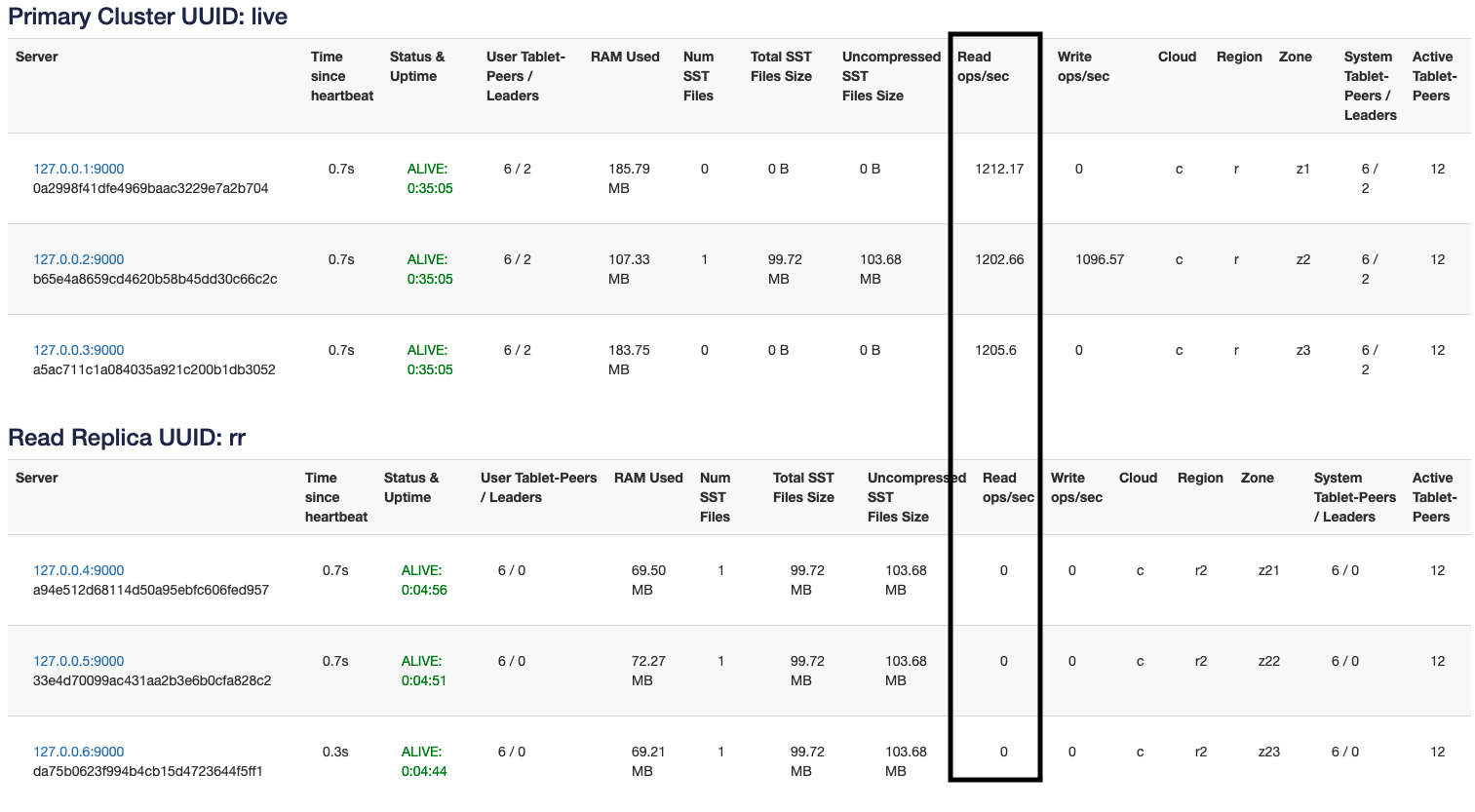
The following command directs the CL.ONE reads to the read replica cluster (as observer reads) in region r2:
java -jar ./yb-sample-apps.jar --workload CassandraKeyValue \
--nodes 127.0.0.1:9042,127.0.0.2:9042,127.0.0.3:9042 \
--nouuid \
--num_unique_keys 2 \
--num_threads_write 1 \
--num_threads_read 1 \
--value_size 1024 --local_reads --with_local_dc r2
The following illustration demonstrates the result of executing the preceding command (visible via YugabyteDB Anywhere):
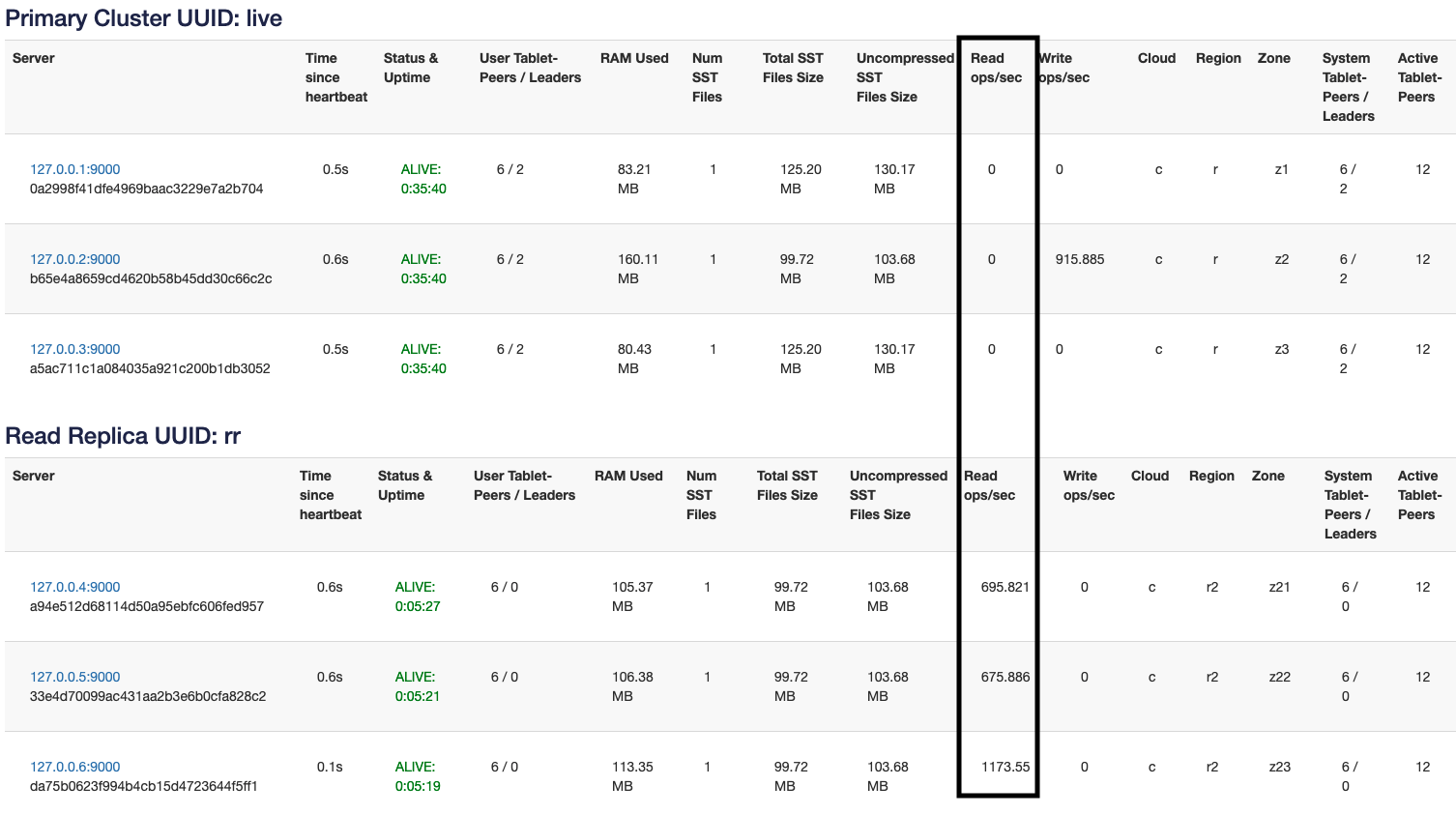
For information on deploying read replicas, see Read Replica Clusters.
Fault tolerance
In the strong consistency mode (default), more failures can be tolerated by increasing the number of replicas: to tolerate a k number of failures, 2k+1 replicas are required in the RAFT group. However, follower reads and observer reads can provide Cassandra-style CL.ONE fault tolerance. The max_stale_read_bound_time_ms GFlag controls how far behind the followers are allowed to be before they redirect reads back to the RAFT leader (the default is 60 seconds). For "write once, read many times" workloads, this number could be increased. By stopping nodes, you can induce behavior of follower and observer reads such that they continue to read (which would not be possible without follower reads).
The following command starts a read-only workload:
java -jar ./yb-sample-apps.jar --workload CassandraKeyValue \
--nodes 127.0.0.1:9042,127.0.0.2:9042,127.0.0.3:9042 \
--nouuid \
--max_written_key 2 \
--read_only \
--num_threads_read 1 \
--value_size 1024 --local_reads --with_local_dc r2 --skip_ddl
The following command stops a node in the read replica cluster:
./bin/yb-ctl stop_node 6
The following illustration demonstrates the stopped node visible via YugabyteDB Anywhere:
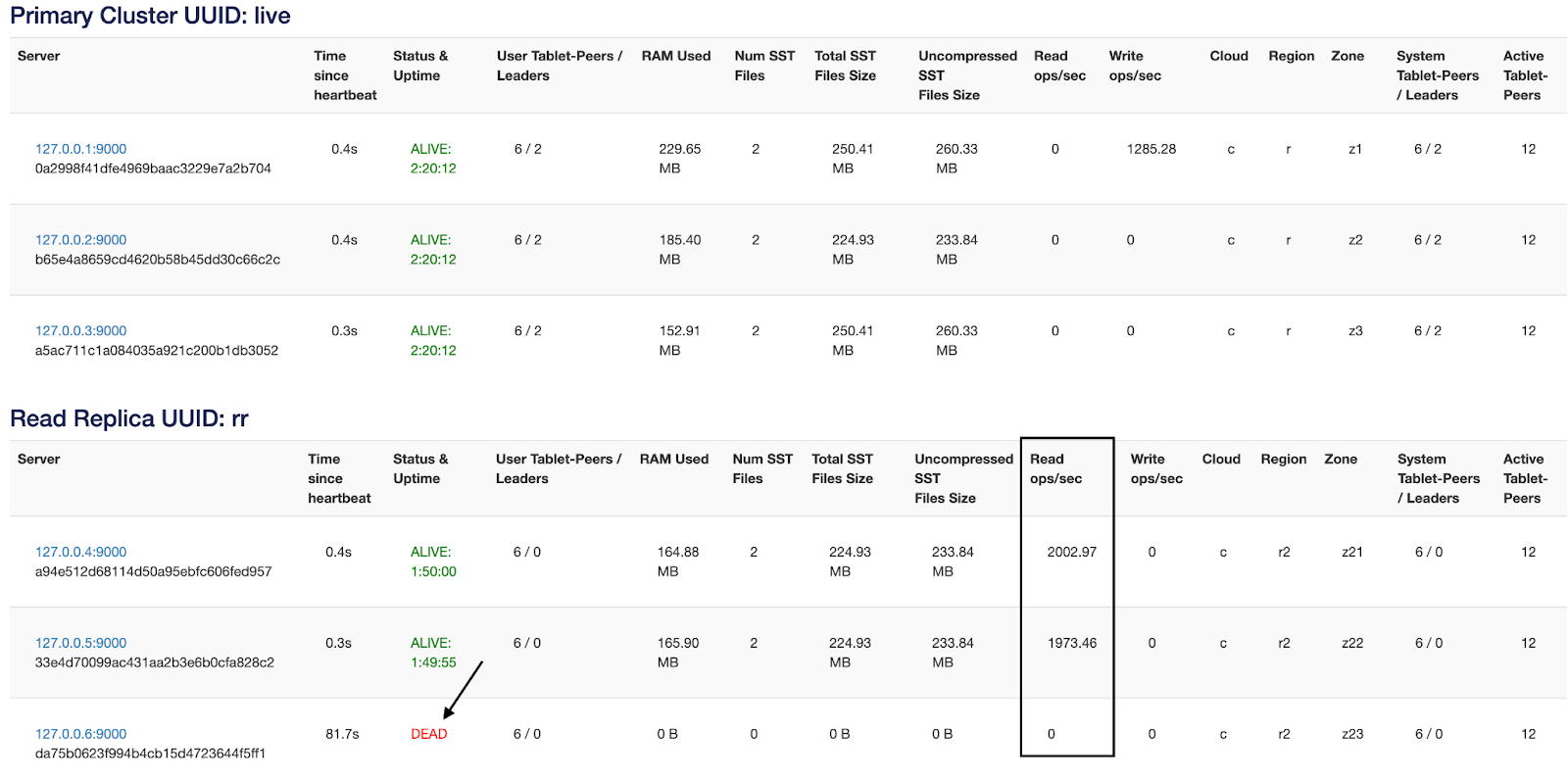
Stopping one node redistributes the load onto the two remaining nodes.
The following command stops another node in the read replica cluster:
./bin/yb-ctl stop_node 5
The following illustration demonstrates two stopped nodes visible via YugabyteDB Anywhere:
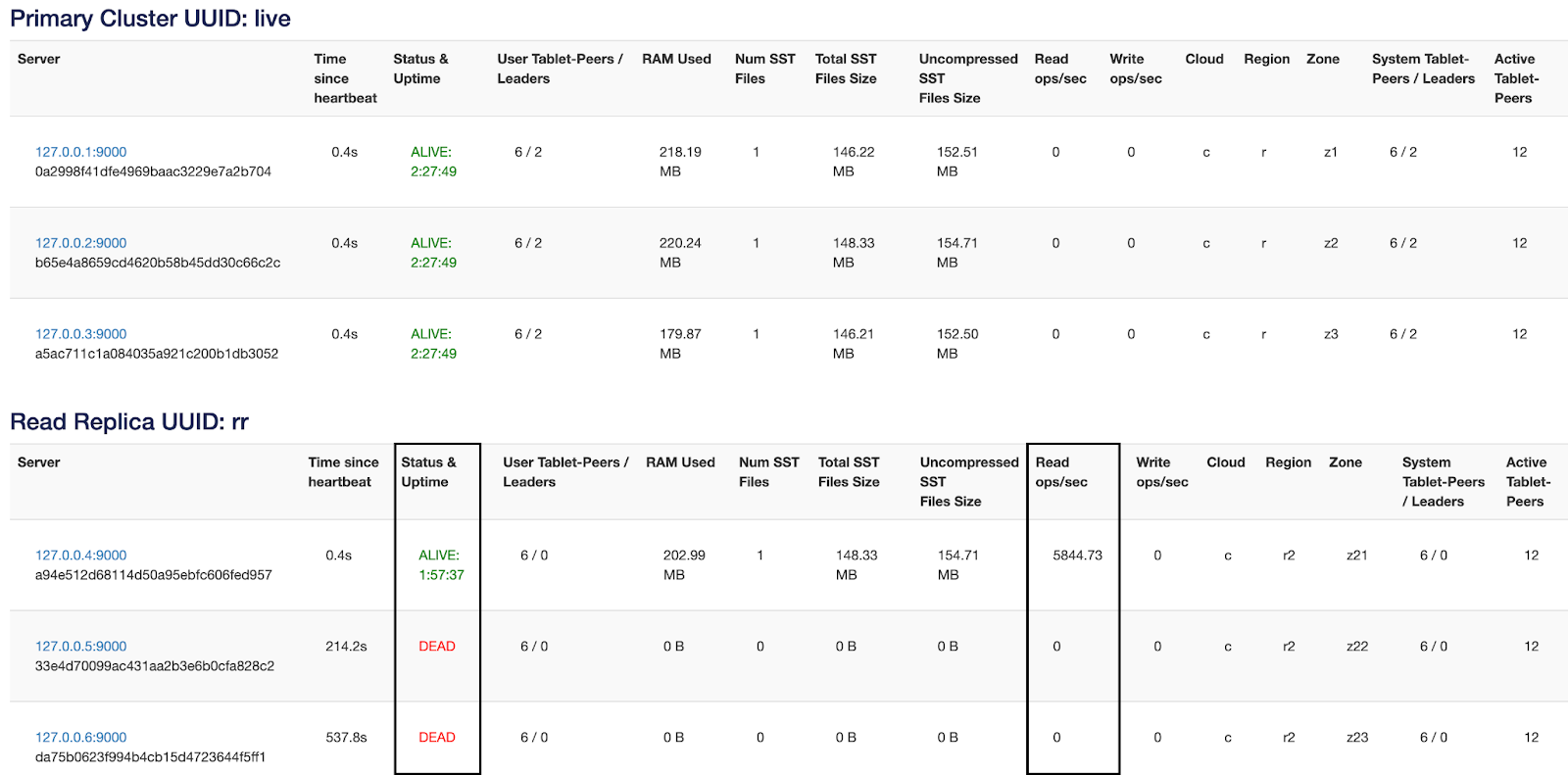
The following command stops the last node in the read replica cluster which causes the reads revert back to the primary cluster and become follower reads:
./bin/yb-ctl stop_node 4
The following illustration demonstrates all stopped nodes in the read replica cluster and activation of nodes in the primary cluster visible via YugabyteDB Anywhere:
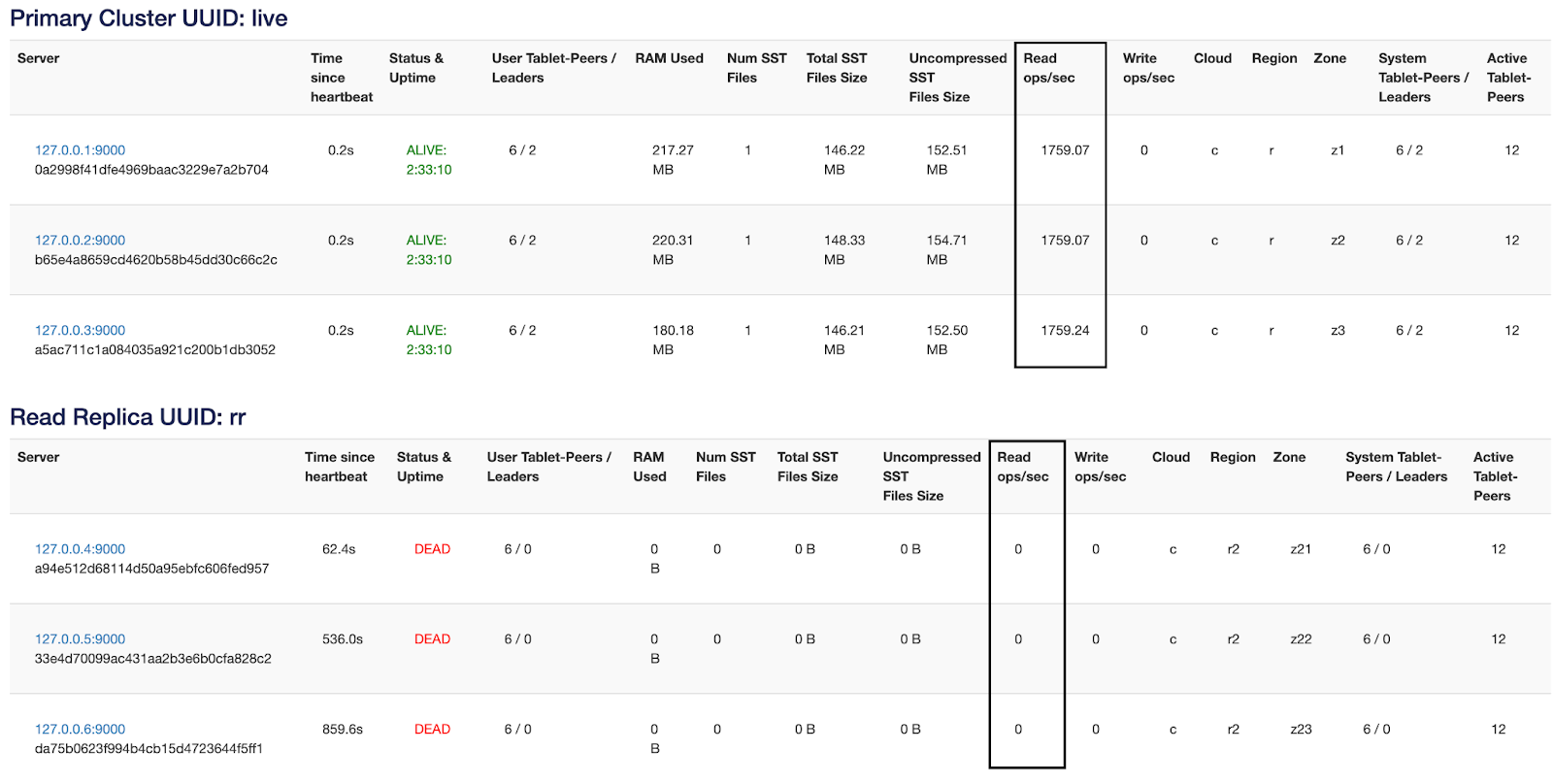
This behavior differs from the standard Cassandra behavior. The YCQL interface only honors consistency level ONE. All other consistency levels are converted to QUORUM including LOCAL_ONE. When a local data center is specified by the application with consistency level ONE, read traffic is localized to the region as long as this region has active replicas. If the application's local data center has no replicas, the read traffic is routed to the primary region.
The following command stops one of the nodes in the primary cluster:
./bin/yb-ctl stop_node 3
The following illustration demonstrates the state of nodes, with read load rebalanced to the remaining nodes visible via YugabyteDB Anywhere:
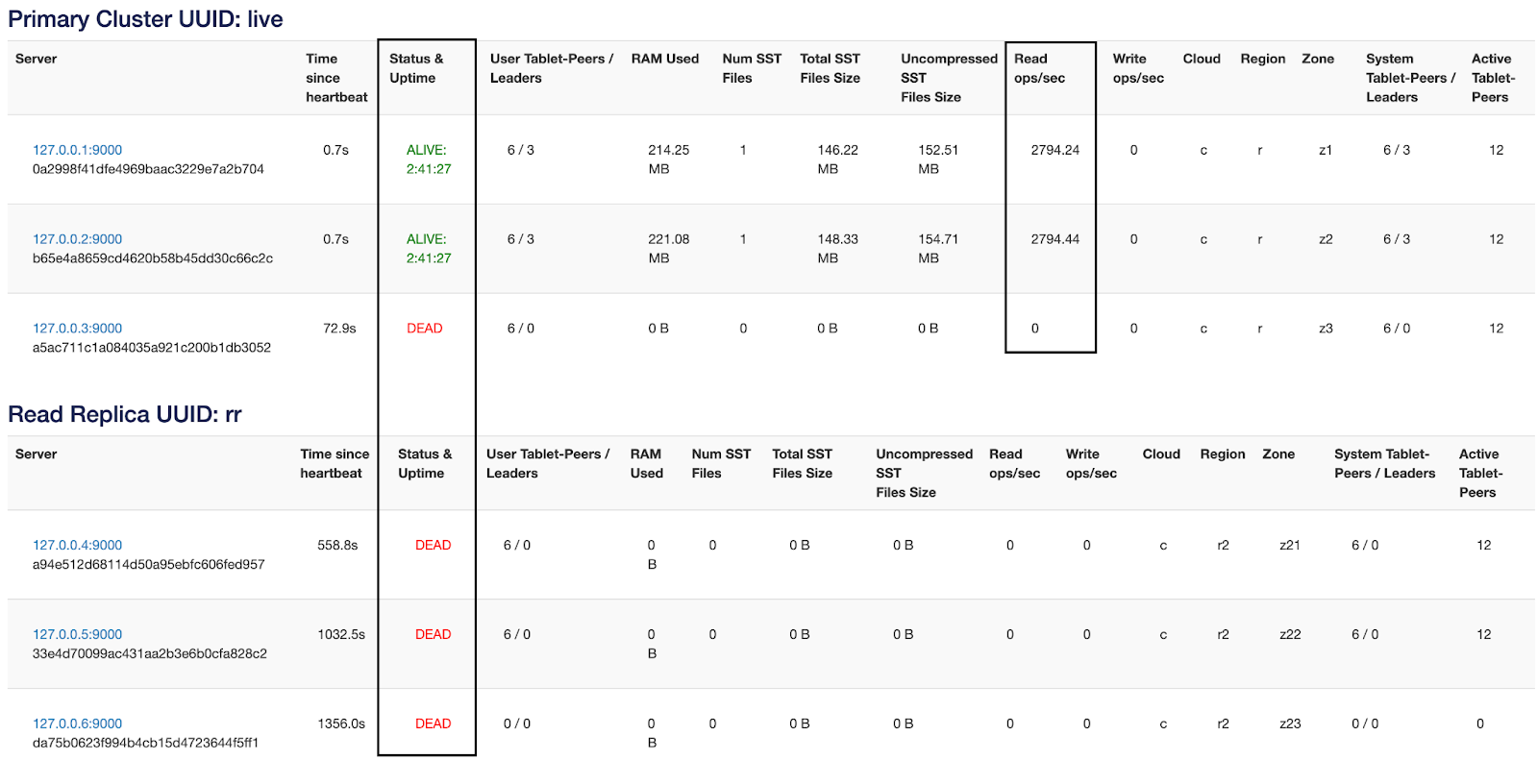
The following command stops one more node in the primary cluster:
./bin/yb-ctl stop_node 2
The following illustration demonstrates that the entire read load moved to the one remaining node visible via YugabyteDB Anywhere:
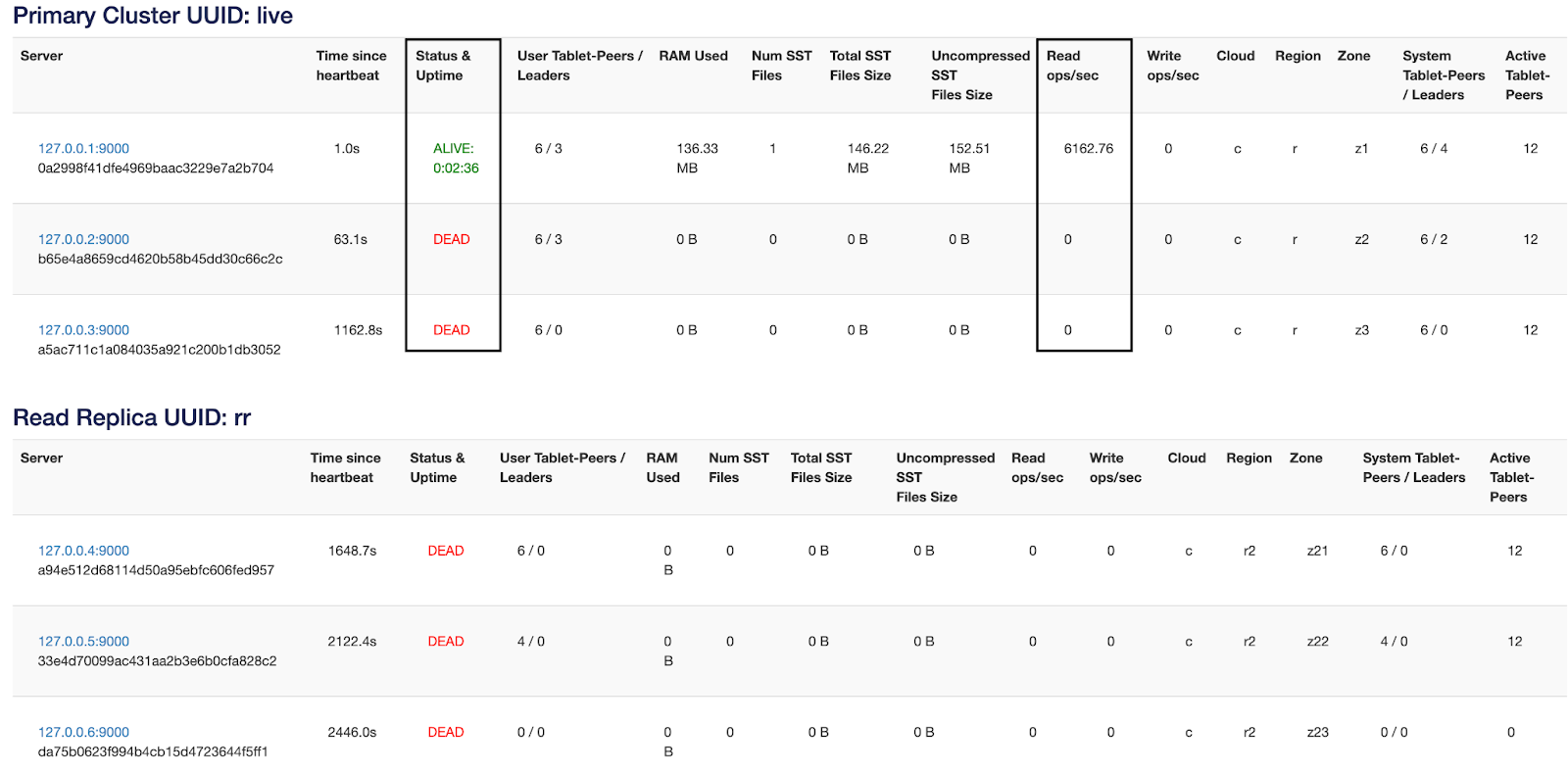
For additional information, see Fault Tolerance.